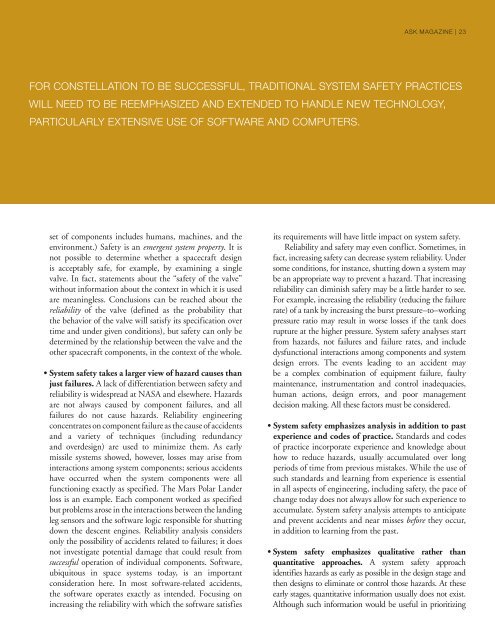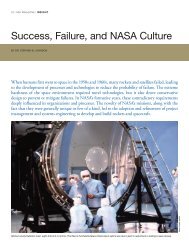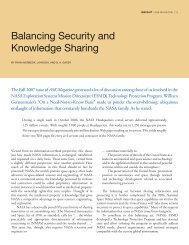An Introduction to System Safety - NASA ASK Magazine
An Introduction to System Safety - NASA ASK Magazine
An Introduction to System Safety - NASA ASK Magazine
Create successful ePaper yourself
Turn your PDF publications into a flip-book with our unique Google optimized e-Paper software.
<strong>ASK</strong> MAGAZINE | 23<br />
FOR CONSTELLATION TO bE SUCCESSFUL, TRADITIONAL SySTEM SAFETy PRACTICES<br />
wILL NEED TO bE REEMPHASIZED AND ExTENDED TO HANDLE NEw TECHNOLOGy,<br />
PARTICULARLy ExTENSIVE USE OF SOFTwARE AND COMPUTERS.<br />
set of components includes humans, machines, and the<br />
environment.) <strong>Safety</strong> is an emergent system property. It is<br />
not possible <strong>to</strong> determine whether a spacecraft design<br />
is acceptably safe, for example, by examining a single<br />
valve. In fact, statements about the “safety of the valve”<br />
without information about the context in which it is used<br />
are meaningless. Conclusions can be reached about the<br />
reliability of the valve (defined as the probability that<br />
the behavior of the valve will satisfy its specification over<br />
time and under given conditions), but safety can only be<br />
determined by the relationship between the valve and the<br />
other spacecraft components, in the context of the whole.<br />
• <strong>System</strong> safety takes a larger view of hazard causes than<br />
just failures. A lack of differentiation between safety and<br />
reliability is widespread at <strong>NASA</strong> and elsewhere. Hazards<br />
are not always caused by component failures, and all<br />
failures do not cause hazards. Reliability engineering<br />
concentrates on component failure as the cause of accidents<br />
and a variety of techniques (including redundancy<br />
and overdesign) are used <strong>to</strong> minimize them. As early<br />
missile systems showed, however, losses may arise from<br />
interactions among system components; serious accidents<br />
have occurred when the system components were all<br />
functioning exactly as specified. The Mars Polar Lander<br />
loss is an example. Each component worked as specified<br />
but problems arose in the interactions between the landing<br />
leg sensors and the software logic responsible for shutting<br />
down the descent engines. Reliability analysis considers<br />
only the possibility of accidents related <strong>to</strong> failures; it does<br />
not investigate potential damage that could result from<br />
successful operation of individual components. Software,<br />
ubiqui<strong>to</strong>us in space systems <strong>to</strong>day, is an important<br />
consideration here. In most software-related accidents,<br />
the software operates exactly as intended. Focusing on<br />
increasing the reliability with which the software satisfies<br />
its requirements will have little impact on system safety.<br />
Reliability and safety may even conflict. Sometimes, in<br />
fact, increasing safety can decrease system reliability. Under<br />
some conditions, for instance, shutting down a system may<br />
be an appropriate way <strong>to</strong> prevent a hazard. That increasing<br />
reliability can diminish safety may be a little harder <strong>to</strong> see.<br />
For example, increasing the reliability (reducing the failure<br />
rate) of a tank by increasing the burst pressure–<strong>to</strong>–working<br />
pressure ratio may result in worse losses if the tank does<br />
rupture at the higher pressure. <strong>System</strong> safety analyses start<br />
from hazards, not failures and failure rates, and include<br />
dysfunctional interactions among components and system<br />
design errors. The events leading <strong>to</strong> an accident may<br />
be a complex combination of equipment failure, faulty<br />
maintenance, instrumentation and control inadequacies,<br />
human actions, design errors, and poor management<br />
decision making. All these fac<strong>to</strong>rs must be considered.<br />
• <strong>System</strong> safety emphasizes analysis in addition <strong>to</strong> past<br />
experience and codes of practice. Standards and codes<br />
of practice incorporate experience and knowledge about<br />
how <strong>to</strong> reduce hazards, usually accumulated over long<br />
periods of time from previous mistakes. While the use of<br />
such standards and learning from experience is essential<br />
in all aspects of engineering, including safety, the pace of<br />
change <strong>to</strong>day does not always allow for such experience <strong>to</strong><br />
accumulate. <strong>System</strong> safety analysis attempts <strong>to</strong> anticipate<br />
and prevent accidents and near misses before they occur,<br />
in addition <strong>to</strong> learning from the past.<br />
• <strong>System</strong> safety emphasizes qualitative rather than<br />
quantitative approaches. A system safety approach<br />
identifies hazards as early as possible in the design stage and<br />
then designs <strong>to</strong> eliminate or control those hazards. At these<br />
early stages, quantitative information usually does not exist.<br />
Although such information would be useful in prioritizing




